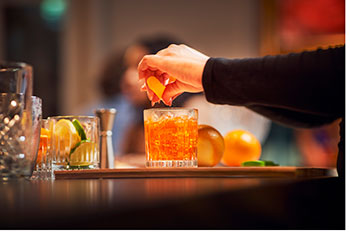|
|
|
You can get e-magazine links on WhatsApp. Click here
|
|
|
|
|
|
“Brands now focusing on lower-alcohol RTD options”
|
|
Monday, 28 October, 2024, 08 : 00 AM [IST]
|
|
|
 The RTD segment is experiencing notable growth, making up US$10.3 billion of the global alcoholic beverages market. This rising popularity reflects not just a demand for convenience but also a broader shift in how young consumers simultaneously prioritise healthy lifestyles and indulgence, stated Sarah Lim, APEC marketing director, beverages, ADM, in an email interaction with FnB News. Excerpts: The RTD segment is experiencing notable growth, making up US$10.3 billion of the global alcoholic beverages market. This rising popularity reflects not just a demand for convenience but also a broader shift in how young consumers simultaneously prioritise healthy lifestyles and indulgence, stated Sarah Lim, APEC marketing director, beverages, ADM, in an email interaction with FnB News. Excerpts:
What are some key trends influencing innovation in alcoholic beverages
In an ever-evolving marketplace, innovation within the alcoholic beverage sector is increasingly being shaped by a discerning consumer base with heightened expectations around health, convenience, and unique flavour experiences. Driven by the ‘sober curious’ movement, modern drinkers are no longer simply seeking indulgence; instead, they are embracing a holistic approach to well-being. As a result, individuals are becoming more mindful of their alcohol consumption and are exploring healthier relationships with drinking.
ADM’s Beverage Innovation Report highlights this shift, revealing that 65% of millennials and 58% of Gen Z are actively seeking “better-for-you” options, including low-sugar, low- or no-alcohol beverages. The rise of the ‘sober curious’ consumer is pushing manufacturers to rethink product formulations, offering a balance between enjoyment and wellness without compromising the social and sensory appeal of drinking.
In addition to the demand for health-focused alcoholic options, there is a growing appetite for flavour exploration. Emerging flavour profiles, twists on classic cocktails, and distinctive combinations are fueling exciting new products in this space. Brands are drawing inspiration from diverse sources, including native ingredients, local cuisine, cultural influences, and elements from nature, to create unique drinking experiences.
 What differences have you observed when it comes to consumers' needs for alcoholic versus non-alcoholic beverages What differences have you observed when it comes to consumers' needs for alcoholic versus non-alcoholic beverages
Consumer needs for alcoholic versus non-alcoholic beverages can differ based on various factors, such as social occasions, shifting lifestyles, and personal preferences. However, a notable trend we have observed across both categories is the impact of growing health consciousness, which is bringing about distinct changes in both segments.
While alcoholic beverages have traditionally been associated with social and celebratory occasions, there is an increasing influence of moderation and wellness. Millennials and Gen Z, in particular, are seeking options that balance indulgence with health consciousness, driving demand for low- and no-alcohol offering.. This shift is paving the way for innovation in alcohol-free and low-alcohol-by-volume (ABV) products, as consumers seek enjoyable drinking experiences while minimising the potential effects of higher alcohol content on their bodies and minds.
On the other hand, non-alcoholic beverages are more heavily driven by their functional benefits. Consumers motivated by self-improvement are turning to these beverages for more than just refreshment; they are seeking targeted health advantages such as hydration, energy boost, digestion, and cognitive function. Hydration remains a top priority, with 54% of consumers using beverages specifically to stay hydrated.
Likewise, the growing demand for beverages that support mental clarity, physical performance, and digestive health has positioned functional waters, carbonated soft drinks (CSDs), ready-to-drink (RTD) tea, and energy drinks as essential solutions that combine flavour with purpose. In the Asia-Pacific (APAC) region, carbonated fruit beverages and energy drinks rank among the top 10 most frequently consumed beverages on a weekly basis.
What are some popular flavour combinations in alcoholic beverages that brands can consider to enhance the consumer's drinking experience?
As consumers become more adventurous, brands have the opportunity to experiment with bold and innovative combinations. ADM's Beverage Innovation Report reveals that millennials and Gen Z are particularly open to new experiences in the beer segment, with 69% and 64%, respectively, expressing interest in trying fresh and exciting flavour profiles. Tropical, exotic, berry, and citrus flavours are among the most appealing, reflecting a rising demand for refreshing alcoholic offerings.
In the spirits segment, the incorporation of diverse ingredients – such as herbs, botanicals, and spices like cherry blossom, coriander, and sage – is gaining popularity due to their natural, fresh appeal. In APAC, the inclusion of regional specialties and seasonal fruits, such as finger lime, pink guava, and pink peppercorn, adds distinct tastes to alcoholic beverages and further enhances their appeal.
Another notable trend is the increasing appeal of unconventional pairings that combine familiar flavours with the exotic. Classic flavours like vanilla and mint, which are widely recognised and accepted, are now being paired with lesser-known ingredients to create more sophisticated, layered profiles. This approach not only broadens consumers' palates but also encourages them to try new flavour pairing options. In fact, 42% of global consumers are more likely to explore new flavours when they are paired with familiar tastes in alcoholic beverages, underscoring the importance of balancing novelty with familiarity.
We leverage our extensive expertise in flavour innovation and consumer insights to help brands create exciting, next-generation beverages that resonate with today’s adventurous drinkers. By utilising our diverse portfolio of ingredients, brands can confidently innovate and explore unique flavour combinations that cater to evolving taste preferences.
The latest Beverage Innovation Report shows that RTD alcoholic beverages have become a hit among young consumers. Why do you think this is, and what other formats are gaining popularity among these consumers?
The RTD segment is experiencing notable growth, making up US$10.3 billion of the global alcoholic beverages market. This rising popularity reflects not just a demand for convenience but also a broader shift in how young consumers simultaneously prioritise healthy lifestyles and indulgence.
Many brands are now focusing on lower-alcohol RTD options, natural ingredients, and unique flavour profiles, appealing to younger consumers who are increasingly seeking balanced indulgence. They are particularly drawn to bold and adventurous options, with spicy, botanical, and fresh fruit options leading the charge. At the same time, classic cocktail profiles like margarita, mojito, and pina colada continue to resonate, tying in with consumers’ desire for both familiarity and novelty.
One of the most prominent trends in the alcoholic beverage segment in recent years is the shift towards at-home drinking. Post-pandemic, younger consumers have embraced the convenience of enjoying premium beverages in the comfort of their homes. While RTD formats have naturally gained popularity due to their ease of consumption, the affordability and simplicity of at-home mixology have further encouraged exploration of new flavours and cross-category concepts. This has driven demand for formats that offer more variety and creativity beyond traditional alcoholic drinks. For example, blended spirits have become a staple in the market, with brands racing to develop innovative combinations that cater to this growing trend.
Beer has also seen a resurgence in at-home consumption, as consumers increasingly appreciate the diversity of flavours within the category. Millennials, in particular, are gravitating toward beer as part of their at-home drinking experiences, with 39% sharing that beer fits their lifestyle. Additionally, more flavourful, higher-ABV craft beers present an opportunity to attract new consumers, especially cocktail and fruity beer enthusiasts, who feel they are getting "more bang for their buck".
What do brands need to do to stand out in the alcoholic beverage segment?
In today’s dynamic alcoholic beverage market, standing out requires more than just delivering a good product; it demands a deep understanding of shifting consumer behaviours and a commitment to innovation.
A major factor shaping the alcoholic beverage landscape in 2024 and beyond is the purchasing power of Gen Z, particularly as they reach legal drinking age. This generation is placing a greater emphasis on long-term wellness, with 71% globally indicating that they adopt a proactive, prevention-focused approach to health. Additionally, convenience continues to be a priority for these young, on-the-go consumer who value efficiency in their daily lives.
By addressing the priorities of convenience, taste quality, and health-consciousness, brands can capture the attention of Gen Z and millennial consumers to establish a lasting presence in the evolving alcoholic beverage market.
We understand that for brands to truly differentiate themselves, they must balance innovation with a deep understanding of changing preferences of different demographics. Our team of skilled flavourists, brewers, and mixologists stays at the forefront of the latest trends and consumer insights within the alcoholic beverages sector. Bolstered by our formulation expertise, product development capabilities, and industry know-how, we support brands in creating their next signature offerings for the modern consumer.
|
|
|
|
|
|
|
|
|
|